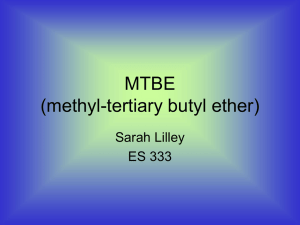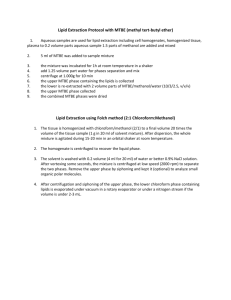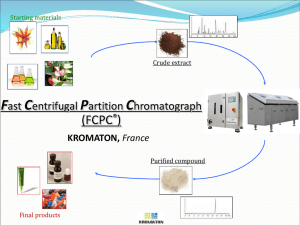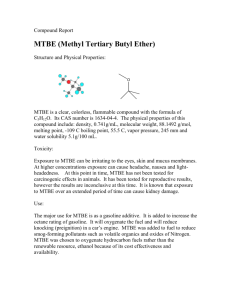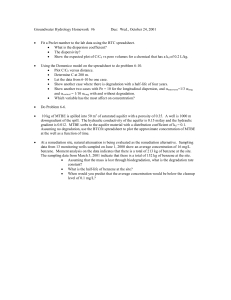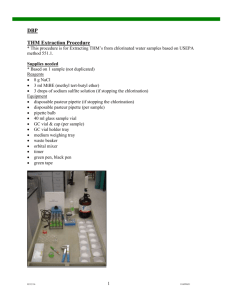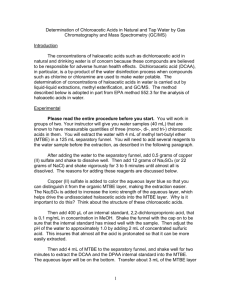Liquid – vapour equilibrium calculations for MTBE/MEOH binary
advertisement
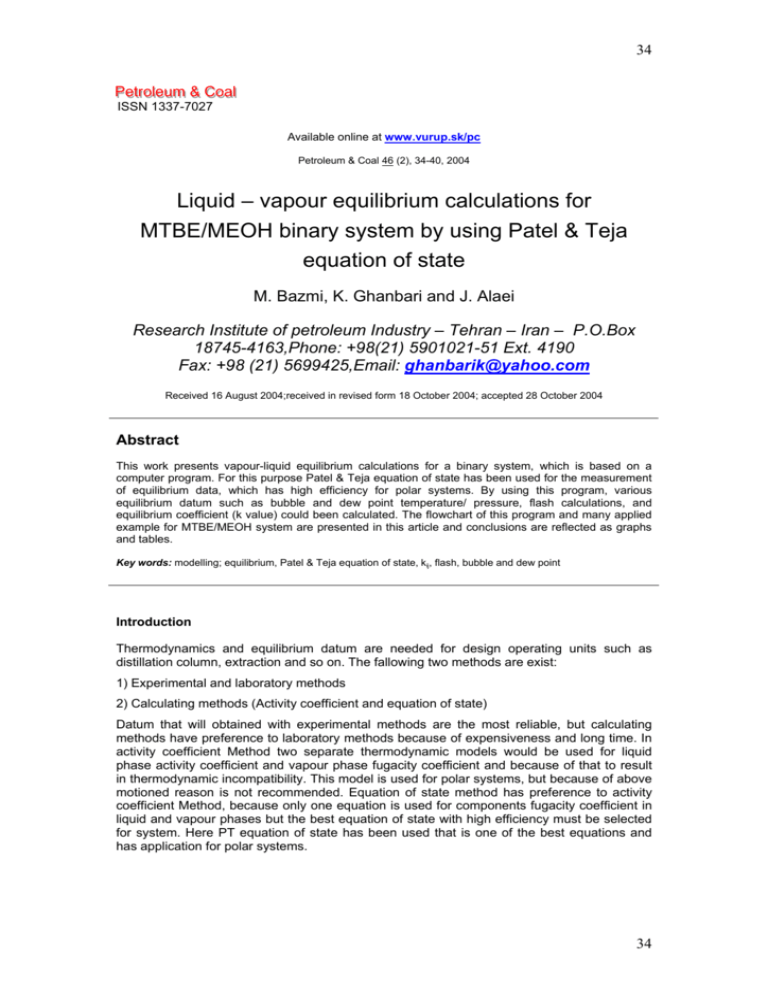
34
PPeettrroolleeuum
m && C
Cooaall
IISSN 1337-7027
Available online at www.vurup.sk/pc
Petroleum & Coal 46 (2), 34-40, 2004
Liquid – vapour equilibrium calculations for
MTBE/MEOH binary system by using Patel & Teja
equation of state
M. Bazmi, K. Ghanbari and J. Alaei
Research Institute of petroleum Industry – Tehran – Iran – P.O.Box
18745-4163,Phone: +98(21) 5901021-51 Ext. 4190
Fax: +98 (21) 5699425,Email: ghanbarik@yahoo.com
Received 16 August 2004;received in revised form 18 October 2004; accepted 28 October 2004
Abstract
This work presents vapour-liquid equilibrium calculations for a binary system, which is based on a
computer program. For this purpose Patel & Teja equation of state has been used for the measurement
of equilibrium data, which has high efficiency for polar systems. By using this program, various
equilibrium datum such as bubble and dew point temperature/ pressure, flash calculations, and
equilibrium coefficient (k value) could been calculated. The flowchart of this program and many applied
example for MTBE/MEOH system are presented in this article and conclusions are reflected as graphs
and tables.
Key words: modelling; equilibrium, Patel & Teja equation of state, kij, flash, bubble and dew point
Introduction
Thermodynamics and equilibrium datum are needed for design operating units such as
distillation column, extraction and so on. The fallowing two methods are exist:
1) Experimental and laboratory methods
2) Calculating methods (Activity coefficient and equation of state)
Datum that will obtained with experimental methods are the most reliable, but calculating
methods have preference to laboratory methods because of expensiveness and long time. In
activity coefficient Method two separate thermodynamic models would be used for liquid
phase activity coefficient and vapour phase fugacity coefficient and because of that to result
in thermodynamic incompatibility. This model is used for polar systems, but because of above
motioned reason is not recommended. Equation of state method has preference to activity
coefficient Method, because only one equation is used for components fugacity coefficient in
liquid and vapour phases but the best equation of state with high efficiency must be selected
for system. Here PT equation of state has been used that is one of the best equations and
has application for polar systems.
34
35
P&T equation of state
This equation is a 3rd order equation of state that has presented in 1982, and it has 3
parameters that are related to critical properties by fallowing equations:
P=
RT
α
−
v − b v (v + b) + c (v − b )
(1)
a = Ω a . ( R 2TC2 / PC ) .α
(2)
b = Ω b . ( RTC / PC )
(3)
c = Ω C . ( RTC / PC )
(4)
Ω C = 1 − 3ξ C
(5)
Ω a = 3ξ + 3 (1 − 2ξ C ) .Ω b + Ω + 1 − 3ξ C
(6)
Ω 3b + ( 2 − 3ξ C ) .Ω b2 + 3ξ C2 .Ω b − ξ C3 = 0
(7)
2
C
2
b
Ω
That b is the smallest positive root of above equation, and α is presented by soave and
peng-Robinson equation:
2
α = ⎡⎣1 + m (1 − TR0.5 ) ⎤⎦
(8)
ξ
m and C parameters are obtained by numerical methods and quantities of these parameters
for MTBE/MEOH system are shown in table 1.
For multi-component systems, mixing rules should be used. For P&T equation of state, these
equations are as fallow:
∑ ∑ x . x .a
am =
i
i
j
(11)
ij
j
∑ x .b
bm =
i
(12)
i
i
Cm =
∑
(13)
x i .c i
i
a ij = k ij ( a ii .a jj )
1
2
(14)
kij parameters namely binary interaction coefficient are experimental parameter and are
calculated by using equilibrium data in binary systems. kij quantity for MTBE/MEOH system is
1.010.
Computer Program Flowchart
For bubble point temperature /pressure calculations, the fallowing equations are confirmed:
y i = k i . xi
i = 1, N
(15)
=1
i = 1, N
(16)
∑y
i
N is number of components and
yi , xi are mole fraction in vapour and liquid phases.
Similarly, for dew point calculations, the following equations are confirmed:
xi = y i / k i
∑x
i
=1
i = 1, N
(17)
i = 1, N
(18)
For calculating of k value, Flash calculations as following equation are used.
F . z i = V . y i + L . xi
(19)
35
36
F is feed mole rate; zi feed mole fraction; V, L in order are component mole rate in equilibrium
vapour and liquid phases.
This equation will obtain with overall mass balance and fallowing equations should be
confirmed:
y i = k i . xi
(20)
=1
(21)
=1
(22)
∑y
∑x
xi =
i
i
zi
L / F + V .k i / F
(23)
The flowchart of bubble point and flash calculations are shown in Fig 1 & 2. In order to know
more about that, refer to reference (4).
Equations of Fugacity calculation are in Appendix A. In flash calculations, note that to guess
first ki, ideal quantities are used (Wilson equation):
ki =
⎡ 5.4(1 + ωi ) ⎤
Pvi PCi
=
Exp ⎢
⎥
P
P
⎣ 1 − TCi / T ⎦
W .eq.
(24)
Discussion and results:
For show prepared computer program efficiency, MTBE/MEOH binary system is selected and
results are compared with experimental datum, that conclusions are in related tables and
figures. Results for bubble point pressure/temperature calculations are shown in tables 2&3.
As it is seeing, absolute deviation average in pressure/ temperature and mole fraction are
less than 5 percent.
Conclusions for dew point temperature/pressure calculations are shown in tables 3&4.
Deviation in pressure and temperature for bubble and dew points are shown in Fig. 3,4,5,6 as
graphs. Just as tables and graphs are saw, PT equation of state will be able to cover
experimental points as well. Thus it is good for design calculations in MTBE system.
Component
Methanol
MTBE
Tc (oR)
922.752
893.52
Pc (psia)
1173.622
488.91
ω
0.556
0.269
M.W.
32.04
88.15
ζc
0.272
0.310
m
0.972708
0.783340
Table 1:Thermodynamic and physical properties
Pexp.
(Psia)
10.46
12.05
12.02
12.95
13.55
13.70
13.82
13.83
13.31
13.50
Total%
Xi,exp.
MTBE
0.1024
0.2240
0.2246
0.2224
0.4854
0.6238
0.7475
0.7523
0.8761
0.8769
Yi,exp.
MTBE
0.2941
0.3857
0.4190
0.5151
0.6121
0.6711
0.7460
0.7384
0.8177
0.8018
Pcal.
Yi,cal.
11.97
12.73
12.78
12.80
13.41
13.48
13.31
13.30
12.87
12.88
0.3758
0.4319
0.4326
0.4325
0.5293
0.6108
0.7086
0.7130
0.8381
0.8390
Abs.
Dev. P
0.1444
0.05643
0.06323
0.01158
0.01033
0.01606
0.03690
0.3832
0.3306
0.0452
Abs.
Dev.Y
0.0817
0.0462
0.0136
0.0826
0.0828
0.0603
0.0373
0.0254
0.0204
0.0372
%4.56
%4.87
36
37
Input Data
Readjust T
Read P,all Xi
NO
YES
NO
Estimate T
Ф=1.0
fiL=fiV
Calculate Mix. Parameters
Liquid Phase
Yi,new = fi L/fiv Yi
Sum2 =Σyi,new
Calculate fi L
Calculate fi v
Yi = fi L/Фi P
Sum1 =ΣYi
Yi=Yi/Sum1
Sum2=1.0
YES
Results
T , Yi , Ki
Calculate Mix. Parameters
Vapor phase
Fig.1 – Flowchart for bubble point calculations
Input Datas
Read T,P
Estimate Ki
Ki=(fiL/Xi)/(fiV/Yi)
Calculations Xi ,Yi
NO
Calculation Mix. Parameters
Liquid phase
Calculation fiL
Sum1=ΣYi
Yi=Yi /Sum1
fiL=fiV
YES
Results
Xi , Yi , Ki
Calculation fiV
Calculation Mix. Parameter
Vapor Phase
Fig.2 – Flowchart for flash calculations
37
38
Table2: Bubble point pressure calculations for MTBE/MEOH system (T= 581.35 oR)
Pexp.
(Psia)
10.46
12.05
12.02
12.95
13.55
13.70
13.82
13.83
13.31
13.50
Total%
Xi,exp.
MTBE
0.1024
0.2240
0.2246
0.2224
0.4854
0.6238
0.7475
0.7523
0.8761
0.8769
Yi,exp.
MTBE
0.2941
0.3857
0.4190
0.5151
0.6121
0.6711
0.7460
0.7384
0.8177
0.8018
Tcal
o
( R)
574.39
578.37
578.05
581.97
581.92
582.26
583.36
588.43
583.12
583.86
Yi,cal.
0.3973
0.4396
0.4416
0.4370
0.5289
0.6106
0.7073
0.7115
0.8378
0.8385
Abs.
Dev. P
0.01197
0.005126
0.005674
0.001066
0.0009805
0.001565
0.003457
0.003578
0.003045
0.004318
% 0.4078
Abs.
Dev.Y
0.1032
0.0539
0.0226
0.0781
0.0832
0.0605
0.0387
0.0269
0.0201
0.0267
%5.239
Table 3: Bubble point temperature calculations for MTBE/MEOH system (Texp. = 581.35 oR)
Pexp.
psia
6.85
6.81
8.17
8.10
8.70
8.67
9.26
9.39
9.51
9.28
X i,exp.
MTBE
0.0955
0.1010
0.2071
0.2247
0.3460
0.3507
0.4881
0.6177
0.7451
0.8704
Y i,exp.
MTBE
0.2731
0.2995
0.4162
0.4425
0.5293
0.5502
0.6198
0.6855
0.7434
0.8512
Pcal.
6.81
7.01
8.20
8.51
9.18
9.24
9.38
9.31
9.24
9.03
X i,cal.
0.0267
0.0329
0.0845
0.1167
0.4407
0.4896
0.6137
0.7071
0.7767
0.8832
Total%
Abs.
Dev. P
0.005839
0.02937
0.003672
0.05062
0.05517
0.06574
0.01296
0.008520
0.02839
0.02694
Abs.
Dev. X
0.0688
0.0681
0.1226
0.102
0.0947
0.1389
0.1256
0.0894
0.0316
0.0128
% 2.87
%8.605
Table4: Dew point pressure calculations for MTBE/MEOH system(Texp. = 563.42 oR)
Pexp.
psia
6.85
6.81
8.17
8.10
8.70
8.67
9.26
9.39
9.51
9.28
Total%
Xi,exp.
MTBE
0.0955
0.1010
0.2071
0.2247
0.3460
0.3507
0.4881
0.6177
0.7451
0.8704
Yi,exp.
MTBE
0.2731
0.2995
0.4162
0.4425
0.5293
0.5502
0.6198
0.6855
0.7434
0.8512
Tcal.
563.15
561.94
563.39
561.52
560.96
560.51
562.99
563.91
564.85
564.76
Xi,cal.
0.0742
0.0895
0.0947
0.1174
0.2478
0.4278
0.4780
0.7048
0.7730
0.8834
Abs.
Dev.T
0.000125
0.000109
0.000217
0.00190
0.000145
0.000226
0.000224
0.000161
0.000584
0.0000240
Abs.
Dev.X
0.0313
0.0115
0.1124
0.1073
0.0982
0.0771
0.0101
0.0871
0.0279
0.013
% 0.0148
%5.659
o
Table 5: Dew point temperature calculations for MTBE/MEOH system (Texp. = 563.42 R)
38
39
Fig.4 - Deviation in bubble point temperature
Fig.3 - Deviation in bubble point pressure
o
(Exp. Temperature 49.82 C)
0
0.5
0.10
0.3
0.05
Deviation
Deviation , psia
(temperature 49.82 C)
0.1
-0.1 0
0.2
0.4
0.6
0.8
1
0.00
0
0.2
0.6
0.8
1
-0.3
-0.10
-0.5
MTBE mole fraction (X)
MTBE mole fraction (X)
Fig.6 - Deviation in Dew point temperature
Fig.5 - Deviation in Dew point pressure
(temperature 39.86
o
o
(Exp. Temprature 39.86 C)
C)
0.5
0.05
0.3
0.03
0.1
-0.1 0
0.2
0.4
0.6
0.8
1
Deviation
Deviation , psia
0.4
-0.05
-0.3
0.01
-0.01 0
0.2
0.4
0.6
0.8
1
-0.03
-0.5
-0.05
MTBE mole fraction (X)
MTBE mole fraction (X)
Appendix A
The equations for fugacity calculation by P&T equation of state:
a) Component fugacity in pure case:
f
a
Z+M
In( ) = Z − 1 − In( Z − B) +
In(
)
p
Z +Q
2 RTN
bP
B=
RT
b+c P
M =
.
2 − N RT
⎡
(b + c) 2 ⎤
N = ⎢bc +
⎥
2 ⎦
⎣
b+c P
Q=
2 + N RT
− 0.5
b) Component fugacity in mixture:
RTIn(
+
xi a ij
fi
b
Q+d
) = − RTIn( Z − B ) + RT ( i ) −
In(
)
Q−d
xi P
v−b
d
⎧ Q+d
a (bi + ci )
a
2Qd ⎫
)+ 2
+ 3 {ci (3b + c) + bi (3c + b)}⎨ In(
⎬
2
2
Q −d2 ⎭
2(Q − d ) 8d
⎩ Q−d
39
40
Q =V +
B=
b+c
2
bPc
RTc
⎡
(b + c) 2 ⎤
d = ⎢bc +
⎥
4 ⎦
⎣
0.5
Abbreviations
a, b, c , m ,α ,ζ , Ω : PT equation of state parameters
f : fugacity
Φ: fugacity coefficient
Kij: interaction coefficient
N: number of components
P: pressure
T: temperature
v : volume
R: universal gas constant
F: feed mole rate
L: liquid phase mole rate
V: gas phase mole rate
X: component mole fraction in liquid phase.
Y: component mole fraction in vapour phase.
Z: component mole fraction in feed.
Subscript
C: Critical properties
i,j: Component No.
m: mixture
Superscript:
L: Liquid phase properties
V: Vapour phase properties
References
[1]
[2]
[3]
[4]
[5]
[6]
[7]
[8]
0
Alm K., “Vapour-pressure, Refractive index at 20 C and vapour liquid equilibria at
101. 325 kpa in the MTBE /MEOH system ”, J. Chem. Eng. Data, 25, 100-103, 1980.
Edmister, Wayne C. Lee: “Applied Hydrocarbon Thermodynamics”, Gulf- Publishing
Co.,1988
Holland C.D.:“ Fundamentals and Modelling of Separation Processes “, Prentice-Hall
Inc., 1975
Maddox R.N.: “Gas conditioning and processing”, Vol. 3, Gulf-Publishing Co., 1990
Mullins R.:“Experimental vapour-liquid equilibria for the system MTBE/MEOH ” ,
AICHE Symposium Series, No. 37, Vol 85.
Patel N.C., Teja A.S.:“ A new cubic equation of state for fluids and fluid mixtures”,
Chem. Eng. Sci, Vol 37, No 3, 463-473, 1982.
Peng D.Y , D.B Robinson: “A New Two-Constant Equation of State“, Ind.
Chem. Eng., Fundamentals ” , Vol. 15, No 1, 59-64, 1976
Soave G.: “Equilibrium constants from a modified Redlich-Kwong equation of state”,
Chem. Eng. Sci , Vol. 27, No 6, 1197-1203,1972
40
